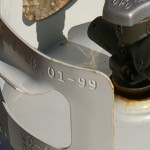By Partisan | From GuerrillaAmerica.com | On Monday, February 25th, 2013
 Let’s face it: your AR-15 (or other black rifle) has a very pronounced silhouette. You may have noticed that a big, black rifle sticks out like a pair of dog balls, especially when its owner is decked out in ACUs. Silhouette, as a military concept, is any shape that’s discernible by its outline. Paper targets with human-sized silhouettes are a perfect example. Our eyes are trained spot these outlines; it’s part of our visual perception. So the purpose of camouflage is to break up a silhouette by blending a shape’s edges with its surroundings. One thing we can do to remedy the silhouette is to paint our battle rifles. (I would even suggest this for hunters and their hunting rifles.) Some may try to replicate digital or ATACS camouflage and that’s alright as long as you blend the outline of your weapon with natural colors of the environment. Here’s how I painted mine without any high tech gadgetry or expensive stencils.
Let’s face it: your AR-15 (or other black rifle) has a very pronounced silhouette. You may have noticed that a big, black rifle sticks out like a pair of dog balls, especially when its owner is decked out in ACUs. Silhouette, as a military concept, is any shape that’s discernible by its outline. Paper targets with human-sized silhouettes are a perfect example. Our eyes are trained spot these outlines; it’s part of our visual perception. So the purpose of camouflage is to break up a silhouette by blending a shape’s edges with its surroundings. One thing we can do to remedy the silhouette is to paint our battle rifles. (I would even suggest this for hunters and their hunting rifles.) Some may try to replicate digital or ATACS camouflage and that’s alright as long as you blend the outline of your weapon with natural colors of the environment. Here’s how I painted mine without any high tech gadgetry or expensive stencils.
If your AR-15 is a luxury item, safe queen or collector’s item, then by all means leave it black. If your AR-15 is a tool that you expect to utilize in defense of your home, community, state, or Constitution, then please consider following these simple steps to reduce your visual profile. Before we begin, this project took me approximately 3 hours to complete, including drying time, for two AR-15s and seven PMAGs. (As a side note, I haven’t camouflaged my optics yet. Those will take more time and a higher attention to detail.)
Ingredients.
I started off at my local hardware store and purchased the following:
- Blue Nitrile Disposable Gloves (10 PK)… $2.48
- Scotch Blue 1.41″ Edgelock Painter’s Tape… $3.93
- Natural Sea Sponge… $8.97
- Rustoleum Spray Paint, Earth Brown… $4.98
- Rustoleum Spray Paint, Dark Forest Green… $4.98
- Rustoleum Spray Paint, Khaki… $4.98
Grand Total…$30.32 (before tax)
I also used two plastic containers and a handful of cotton balls from the house. You’ll definitely need these.
Depending on your locale and the colors natural to your environment, consider using different shades. I prefer the three color (khaki, green, brown) camouflage for where I live. If I lived in the Florida swamps, I might consider using black instead of khaki. Just observe your surroundings and make changes to this recipe as necessary. Before we get to Step One, just remember safety first. I won’t bore you with OSHA standards.
Magazines.
 Start out by taping your magazines. I inserted one to get a good idea of exactly where it sat, and, using painter’s tape, I covered everything that would fit inside the magazine well. My magazines tend to fit pretty tightly as it is, so I didn’t want to create any problems when inserting them into the magazine well. Any additional friction could cause even minute problems when inserting a full or dropping an empty magazine, and those are problems we just don’t want. If you use PMAGS with windows, be sure to cover those windows up. Just cut thin strips roughly the size of those windows and apply them. Lastly, don’t forget to cover up the top of the magazine where the follower is visible. If you can see it, it will get paint on it. (As a side note, be sure to clean and dry your magazines if they are dirty, prior to painting.) I recommend wearing gloves when painting so the paint doesn’t get on your hands. Spray paint sticks to things, including your hands, and it’s huge pain to clean off.
Start out by taping your magazines. I inserted one to get a good idea of exactly where it sat, and, using painter’s tape, I covered everything that would fit inside the magazine well. My magazines tend to fit pretty tightly as it is, so I didn’t want to create any problems when inserting them into the magazine well. Any additional friction could cause even minute problems when inserting a full or dropping an empty magazine, and those are problems we just don’t want. If you use PMAGS with windows, be sure to cover those windows up. Just cut thin strips roughly the size of those windows and apply them. Lastly, don’t forget to cover up the top of the magazine where the follower is visible. If you can see it, it will get paint on it. (As a side note, be sure to clean and dry your magazines if they are dirty, prior to painting.) I recommend wearing gloves when painting so the paint doesn’t get on your hands. Spray paint sticks to things, including your hands, and it’s huge pain to clean off.
 Finally, we can begin to spray paint. From 12-18 inches between the magazine and the spray can, begin spray painting a khaki base and ensure an even coating. If you hold the can too close, you’ll start pooling paint and cause it to run. Don’t forget to paint both the sides and bottoms of your magazines.
Finally, we can begin to spray paint. From 12-18 inches between the magazine and the spray can, begin spray painting a khaki base and ensure an even coating. If you hold the can too close, you’ll start pooling paint and cause it to run. Don’t forget to paint both the sides and bottoms of your magazines.
Drying times will vary based on temperature and humidity. I waited approximately 15 minutes before I flipped them over to paint the other side. However long you wait, just make sure the paint is dry. Typically, if the paint is shiny, it’s still wet. Once you’ve applied a base coat to both sides and allowed time to dry, break out the natural sea sponge.
I tore my sponge into two pieces. The great thing about using sea sponge is that it’s naturally porous; and ripping it in half will cause parts to jut in and out which gives us a great texture for camouflage. Using a plastic cup or container, I took out the green spray paint and started to fill the container. The spray paint will pool inside the container, and you’ll use this wet paint to dip the sponge.
 Once you have paint on the sponge, test it on some cardboard to make sure that the pattern is good. I don’t recommend a solid coating, and little breaks in the design is best. Remember, randomness and unpredictability in the pattern is what we’re going for. Start by blotting the sponge from top to bottom, and dip the sponge into the paint again as needed. Find a blotting pattern that you like (top to bottom, left to right, checkered, etc.) or experiment with something different. Your best practices from camouflaging your magazines will come in handy when you paint your battle rifle.
Once you have paint on the sponge, test it on some cardboard to make sure that the pattern is good. I don’t recommend a solid coating, and little breaks in the design is best. Remember, randomness and unpredictability in the pattern is what we’re going for. Start by blotting the sponge from top to bottom, and dip the sponge into the paint again as needed. Find a blotting pattern that you like (top to bottom, left to right, checkered, etc.) or experiment with something different. Your best practices from camouflaging your magazines will come in handy when you paint your battle rifle.
 Allow time to dry, then flip and repeat. Once the green paint is applied, do the same for brown. I used a smaller sponge area for the brown paint. You should try to cover up the most open areas of khaki but also apply brown in some places over the green. Remember to produce random patterns. If you mess up or don’t like the pattern, you can start all over with another base coat of khaki. Just be sure to get it right prior painting your rifle.
Allow time to dry, then flip and repeat. Once the green paint is applied, do the same for brown. I used a smaller sponge area for the brown paint. You should try to cover up the most open areas of khaki but also apply brown in some places over the green. Remember to produce random patterns. If you mess up or don’t like the pattern, you can start all over with another base coat of khaki. Just be sure to get it right prior painting your rifle.
Rifle painting.
I can understand some hesitation in painting your prized AR-15 or other battle rifle. I love my AR-15s like family because I understand their importance to my future safety and survival. Each looks different, weighs different, and has a different feel in my hands.  Your rifles are no different; each is its own beautiful masterpiece. The bottom line, however, is that you wear camouflage while hunting or training to break up your silhouette, and your rifle – a tool – deserves the same tactical advantage. If you allow your rifle to remain black and expect to use it while wearing camouflage, you’re setting yourself up for potential failure. Black simply stands out against camouflage. Keep in mind that this isn’t an art contest. As soon as I had finished painting these two ARs, I thought I had made a horrendous mistake. But after letting them sit and dry overnight, I came back in the morning with a new appreciation.
Your rifles are no different; each is its own beautiful masterpiece. The bottom line, however, is that you wear camouflage while hunting or training to break up your silhouette, and your rifle – a tool – deserves the same tactical advantage. If you allow your rifle to remain black and expect to use it while wearing camouflage, you’re setting yourself up for potential failure. Black simply stands out against camouflage. Keep in mind that this isn’t an art contest. As soon as I had finished painting these two ARs, I thought I had made a horrendous mistake. But after letting them sit and dry overnight, I came back in the morning with a new appreciation.
 I began by removing the bolt carrier. To be on the safe side, and regardless of how tightly your upper and lower receivers fit against each other, I recommend putting cotton balls in the top of the magazine and chamber, all the way back to the grip. Use those cotton balls to seal any gap between the receivers and prevent paint from getting inside the weapon. Additionally, you’ll want to put part of a cotton ball where your flash suppressor and the end of the barrel meet.
I began by removing the bolt carrier. To be on the safe side, and regardless of how tightly your upper and lower receivers fit against each other, I recommend putting cotton balls in the top of the magazine and chamber, all the way back to the grip. Use those cotton balls to seal any gap between the receivers and prevent paint from getting inside the weapon. Additionally, you’ll want to put part of a cotton ball where your flash suppressor and the end of the barrel meet.
You can leave your optics on, if you’d like. I removed mine because they are going to require a little more TLC. Either way, be sure to tape up any glass on them, even if you have plastic covers on your scope or CCO. I taped up my MAGPUL MOE grips because I like the texture they have and because my hand will be covering them. I taped up my trigger for the same reasons. If your trigger is shiny metal, you could use a different kind of paint to black it out. I also taped over my serial numbers. Finally, I taped up the rear aperture on my flip sites. Then the fun began.
 Just like we did with the magazines, begin by spraying a khaki base coat on your weapon. Be sure to paint the top and bottom of the weapon as well, along with all those nooks and crannies. I extended my butt stock all the way back so as to not leave a large black spot. Be sure to leave a light coat over the buffer spring tube so you’ll be able to extend and collapse the butt stock as necessary and without trouble. A light coat did not gunk up my fire selector switch, bolt lock release, or magazine drop; light being the operative word. After that coat dries, flip it over and do the other side.
Just like we did with the magazines, begin by spraying a khaki base coat on your weapon. Be sure to paint the top and bottom of the weapon as well, along with all those nooks and crannies. I extended my butt stock all the way back so as to not leave a large black spot. Be sure to leave a light coat over the buffer spring tube so you’ll be able to extend and collapse the butt stock as necessary and without trouble. A light coat did not gunk up my fire selector switch, bolt lock release, or magazine drop; light being the operative word. After that coat dries, flip it over and do the other side.
 Just like we did with our magazines, use the sea sponge to start blotting green paint in random schemes across the weapon. Don’t forget to blot parts on top and bottom as well, along with flip up sights or scope/CCO. Once both sides are done and dry, add some brown in the same fashion. I let them sit over night to dry. I also didn’t add any heat source to cure the paint. (The brown was a little dark when first applied but lightened in color once it dried.)
Just like we did with our magazines, use the sea sponge to start blotting green paint in random schemes across the weapon. Don’t forget to blot parts on top and bottom as well, along with flip up sights or scope/CCO. Once both sides are done and dry, add some brown in the same fashion. I let them sit over night to dry. I also didn’t add any heat source to cure the paint. (The brown was a little dark when first applied but lightened in color once it dried.)
Range day.
I took them to the range the next day and was approached by a few people asking how I did the camouflage pattern. (Welcome to the blog.) One even thought that I had purchased it like that. After the congratulations, I was a little concerned with the heat causing paint chipping, especially on the barrel. After unloading a few magazines and warming things up, I inspected and found no chipping. The only ‘issue’ I observed was a little blackening of paint on the flash suppressor, which really is a non-issue. I’ll post a six month update or note when the paint starts to crack or chip, which ever comes first.
And there you have it:

—
Source: http://guerrillamerica.com/2013/02/camouflage-your-ar-15/







